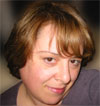If you look at the Panel 4 of Page 27 in the previous post, you see Glen Smith's figure is covered with effect lines. I assumed effect lines indicate motion, so I wasn't sure what motion it referred to in that picture, and asked my husband for help.
He explained that effect lines are not just about motion. In this particular example, they indicate that attention is suddenly focused on Edgar. Perhaps a zoom would be used to achieve the same effect in a live action film.
We had an interesting conversation about how influential these effect lines have become. It turns out that they are even utilized often in anime, where characters are obviously capable of moving for real (as opposed to requiring symbols for movement, as in comics), but the lines are a carryover from manga tradition, and are also used as extra emphasis within these anime. It is such an integral part of the visual vocabulary of manga/anime, that when an American special effects guy my husband knows suggested to a CG director at Studio Ghibli that they use a motion blur effect (standard part of Photoshop and After Effects) instead, they declined.
Another issue Japanese anime creators faced when they tried to incorporate 3D CG was line weight. Line weight (in other words, the thickness of a line) is so critical in expressing personality and an emotional tone that to avoid the necessary standardization of line weight that CG would result in, animators tend to use it only for backgrounds, which are less important in setting the mood, and continue to hand-draw actual characters.
Friday, April 27, 2007
Effect Lines and other wonderful things
Labels:
Anime,
Comics,
Comment,
Effect Line,
Moto Hagio,
Shojo,
Studio Ghibli
Subscribe to:
Post Comments (Atom)


No comments:
Post a Comment